AMD Ryzen 5 3600 Review: Why Is This Amazon's Best Selling CPU?
by Dr. Ian Cutress on May 18, 2020 9:00 AM ESTCPU Performance: System Tests
Our System Test section focuses significantly on real-world testing, user experience, with a slight nod to throughput. In this section we cover application loading time, image processing, simple scientific physics, emulation, neural simulation, optimized compute, and 3D model development, with a combination of readily available and custom software. For some of these tests, the bigger suites such as PCMark do cover them (we publish those values in our office section), although multiple perspectives is always beneficial. In all our tests we will explain in-depth what is being tested, and how we are testing.
All of our benchmark results can also be found in our benchmark engine, Bench.
Application Load: GIMP 2.10.4
One of the most important aspects about user experience and workflow is how fast does a system respond. A good test of this is to see how long it takes for an application to load. Most applications these days, when on an SSD, load fairly instantly, however some office tools require asset pre-loading before being available. Most operating systems employ caching as well, so when certain software is loaded repeatedly (web browser, office tools), then can be initialized much quicker.
In our last suite, we tested how long it took to load a large PDF in Adobe Acrobat. Unfortunately this test was a nightmare to program for, and didn’t transfer over to Win10 RS3 easily. In the meantime we discovered an application that can automate this test, and we put it up against GIMP, a popular free open-source online photo editing tool, and the major alternative to Adobe Photoshop. We set it to load a large 50MB design template, and perform the load 10 times with 10 seconds in-between each. Due to caching, the first 3-5 results are often slower than the rest, and time to cache can be inconsistent, we take the average of the last five results to show CPU processing on cached loading.
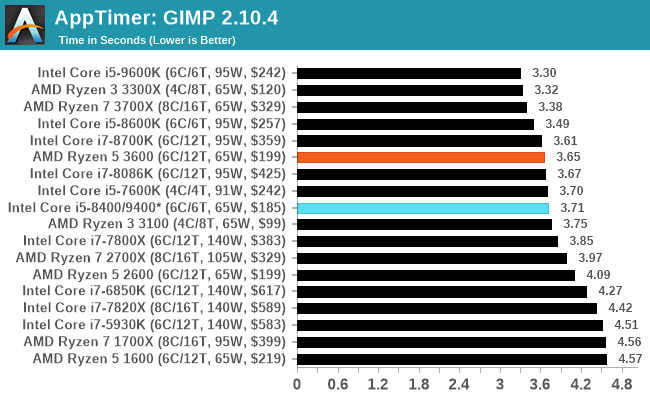
Not much difference here between the i5-8400 and the Ryzen 5 3600.
3D Particle Movement v2.1: Brownian Motion
Our 3DPM test is a custom built benchmark designed to simulate six different particle movement algorithms of points in a 3D space. The algorithms were developed as part of my PhD., and while ultimately perform best on a GPU, provide a good idea on how instruction streams are interpreted by different microarchitectures.
A key part of the algorithms is the random number generation – we use relatively fast generation which ends up implementing dependency chains in the code. The upgrade over the naïve first version of this code solved for false sharing in the caches, a major bottleneck. We are also looking at AVX2 and AVX512 versions of this benchmark for future reviews.
For this test, we run a stock particle set over the six algorithms for 20 seconds apiece, with 10 second pauses, and report the total rate of particle movement, in millions of operations (movements) per second. We have a non-AVX version and an AVX version, with the latter implementing AVX512 and AVX2 where possible.
3DPM v2.1 can be downloaded from our server: 3DPMv2.1.rar (13.0 MB)
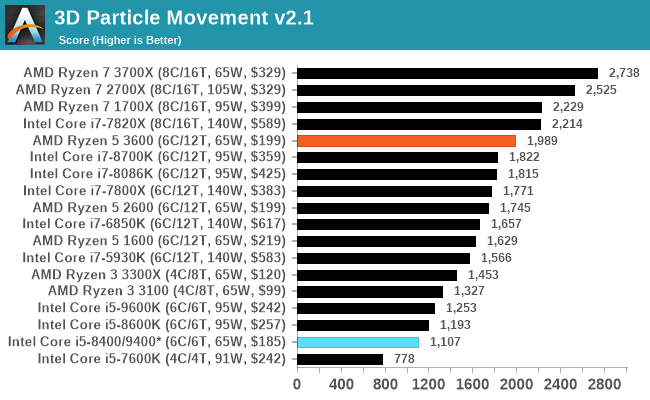
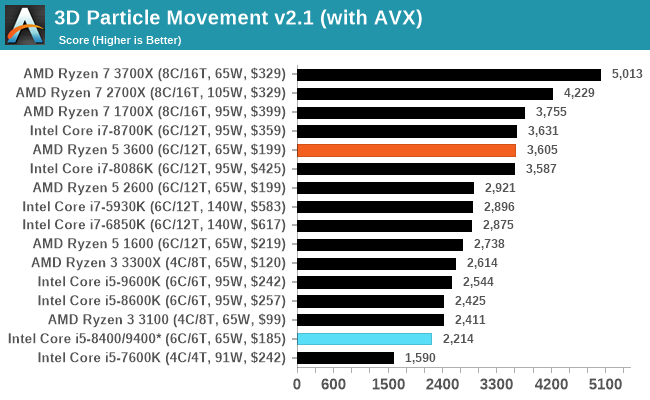
The core deficit comes on strong in 3DPM.
Dolphin 5.0: Console Emulation
One of the popular requested tests in our suite is to do with console emulation. Being able to pick up a game from an older system and run it as expected depends on the overhead of the emulator: it takes a significantly more powerful x86 system to be able to accurately emulate an older non-x86 console, especially if code for that console was made to abuse certain physical bugs in the hardware.
For our test, we use the popular Dolphin emulation software, and run a compute project through it to determine how close to a standard console system our processors can emulate. In this test, a Nintendo Wii would take around 1050 seconds.
The latest version of Dolphin can be downloaded from https://dolphin-emu.org/
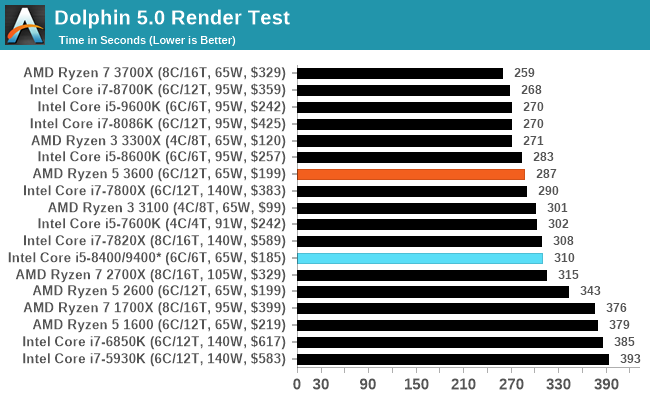
The Ryzen 5 3600 has better single threaded performance, and so the Dolphin emulation scores better with AMD.
DigiCortex 1.20: Sea Slug Brain Simulation
This benchmark was originally designed for simulation and visualization of neuron and synapse activity, as is commonly found in the brain. The software comes with a variety of benchmark modes, and we take the small benchmark which runs a 32k neuron / 1.8B synapse simulation, equivalent to a Sea Slug.
Example of a 2.1B neuron simulation
We report the results as the ability to simulate the data as a fraction of real-time, so anything above a ‘one’ is suitable for real-time work. Out of the two modes, a ‘non-firing’ mode which is DRAM heavy and a ‘firing’ mode which has CPU work, we choose the latter. Despite this, the benchmark is still affected by DRAM speed a fair amount.
DigiCortex can be downloaded from http://www.digicortex.net/
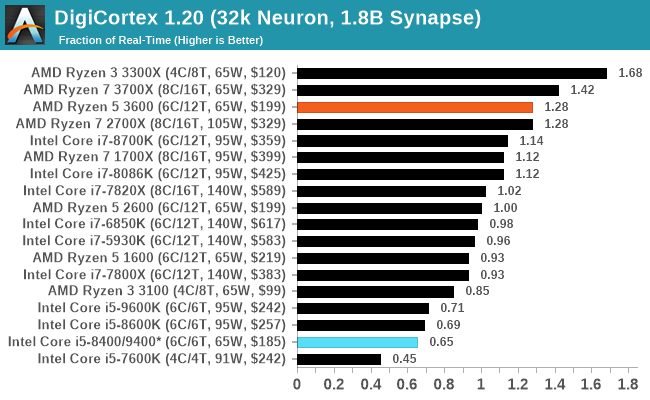
Dual DDR4-2666 doesn't mode well for the Intel processor.
y-Cruncher v0.7.6: Microarchitecture Optimized Compute
I’ve known about y-Cruncher for a while, as a tool to help compute various mathematical constants, but it wasn’t until I began talking with its developer, Alex Yee, a researcher from NWU and now software optimization developer, that I realized that he has optimized the software like crazy to get the best performance. Naturally, any simulation that can take 20+ days can benefit from a 1% performance increase! Alex started y-cruncher as a high-school project, but it is now at a state where Alex is keeping it up to date to take advantage of the latest instruction sets before they are even made available in hardware.
For our test we run y-cruncher v0.7.6 through all the different optimized variants of the binary, single threaded and multi-threaded, including the AVX-512 optimized binaries. The test is to calculate 250m digits of Pi, and we use the single threaded and multi-threaded versions of this test.
Users can download y-cruncher from Alex’s website: http://www.numberworld.org/y-cruncher/
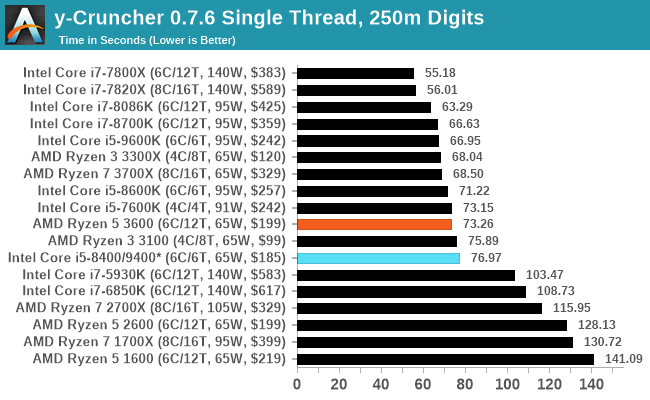

While almost similar in AVX2 in ST mode, the lack of threads again hurts the i5-8400, giving the win to the Ryzen 5 3600. Zen 2 does well here.
Agisoft Photoscan 1.3.3: 2D Image to 3D Model Conversion
One of the ISVs that we have worked with for a number of years is Agisoft, who develop software called PhotoScan that transforms a number of 2D images into a 3D model. This is an important tool in model development and archiving, and relies on a number of single threaded and multi-threaded algorithms to go from one side of the computation to the other.
In our test, we take v1.3.3 of the software with a good sized data set of 84 x 18 megapixel photos and push it through a reasonably fast variant of the algorithms, but is still more stringent than our 2017 test. We report the total time to complete the process.
Agisoft’s Photoscan website can be found here: http://www.agisoft.com/
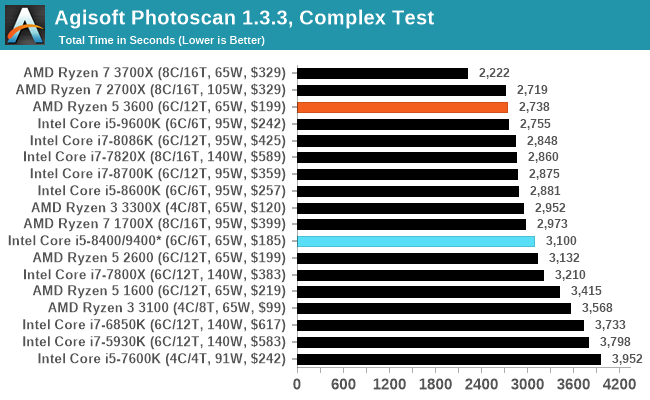












114 Comments
View All Comments
PeachNCream - Monday, May 18, 2020 - link
Anandtech spends a lot of time on gaming and on desktop PCs that are not representative of where and how people now accomplish compute tasks. They do spend a little time on mobile phones and that nets part of the market, but only at the pricey end of cellular handsets. Lower cost mobile for the masses and work-a-day PCs and laptops generally get a cursory acknowledgement once in a great while which is disappointing because there is a big chunk of the market that gets disregarded. IIRC, AT didn't even get around to reviewing the lower tiers of discrete GPUs in the past, effectively ignoring that chunk of the market until long after release and only if said lower end hardware happened to be in a system they ended up getting. They do not seem to actively seek out such components, sadly enough.whatthe123 - Monday, May 18, 2020 - link
AI/tensorflow runs so much faster even on mid tier GPUs that trying to argue CPUs are relevant is completely out of touch. No academic in their right mind is looking for a bang-for-buck CPU to train models, it would be an absurd waste of time.wolfesteinabhi - Tuesday, May 19, 2020 - link
well ..games also run on GPU ...so why bother benchmarking CPU's with them? ... same reason why anyone would want to look at other workflows .. i said tensor flow as just one of the examples(maybe not the best example) ..but more of such "work" or "development" oriented benchmarks.pashhtk27 - Thursday, May 21, 2020 - link
Or there should be proper support libraries for the integrated graphics to run tensor calculations. That would make GPU-less AI development machines a lot more cost effective. AMD and Intel are both working on this but it'll be hard to get around Nvidia's monopoly of AI computing. Free cloud compute services like colab have several problems and others are very cost prohibitive for students. And sometimes you just need to have a local system capable of loading and predicting. As a student, I think it would significantly lower the entry threshold if their cost effective laptops could run simple models and get output.We can talk about AI benchmarks then.
Gigaplex - Monday, May 18, 2020 - link
As a developer I just use whatever my company gives me. I wouldn't be shopping for consumer CPUs for work purposes.wolfesteinabhi - Tuesday, May 19, 2020 - link
not all developers are paid by their companies or make money with what they develop ... some are hobbyists and some do it as their "side" activities and with their own money at home apart from what they do at work with big guns!.mikato - Sunday, May 24, 2020 - link
As a developer, I built my own new computer at work and got to pick everything within budget.Achaios - Monday, May 18, 2020 - link
"Every so often there comes a processor that captures the market. "This used to be Sandy Bridge I5-2500K, all time best seller.
Oh, how the Mighty Chipzilla has fallen.
mikelward - Monday, May 18, 2020 - link
My current PC is a 2500K. My next one will be a 3600.Spunjji - Tuesday, May 19, 2020 - link
Sandy was an absolute knockout. Most of the development thereafter was aimed at sticking similarly powerful CPUs in sleeker packages rather than increasing desktop performance, and while I feel like Intel deserve more credit for some things than they get (e.g. the leap in mobile power/performance that can from Haswell) they really shit the bed on 10nm and responding to Ryzen.